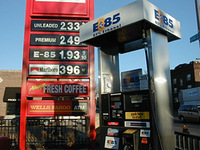GM Seeking More U.S. Ethanol Fueling Stations
SEE ALSO: Alcohol and Driving DO Mix
SEE ALSO: Ethanol Articles on TACH
KISSIMMEE, Fla., Feb 16, 2010; Bernie Woodall writing for Reuters reported General Motors Co's growing output of vehicles capable of running on ethanol-gasoline blends won't help cut polluting emissions or U.S. dependence on foreign oil until a slim network of stations dispensing ethanol is greatly expanded, GM Vice Chairman Tom Stephens said.
Half of GM's vehicle lineup will be able to run on a mix of 15 percent gasoline and 85 percent ethanol, called E85, by the 2012 model year, said Stephens, GM's vice chairman for global product operations.
"GM is spending about $100 million a year adding flex-fuel capability to our vehicles. We can't afford to leave this capital stranded," Stephens said in a speech on Tuesday at the Renewable Fuels Association conference.
A copy of the speech was provided to reporters on Monday.
Adding the capability to run on E85 costs adds as much as $70 to the production cost of each vehicle, Stephens said.
GM has produced 4 million of the 7.5 million flex-fuel vehicles on U.S. roads now, said Coleman Jones, GM biofuel implementation manager.
Stephens said GM has worked with the National Governor's Association and ethanol producers and dispensers to add 350 more ethanol-blend pumps in the United States. He said GM would welcome federal government assistance to finance expansion of that network, but he offered no specifics on how that would work.
"Today there's 2,200 (ethanol fuel stations) that are out there but that's not enough," said Stephens.
"Two-thirds of the pumps are concentrated in 10 states and those 10 states have only about 19 percent of the flex-fuel vehicles that we have on the road," said Stephens. "That's a big problem for us."
Those 10 states are all in the Midwest, heart of corn production in the United States. Corn is the dominant source of U.S.-produced ethanol.
Stephens said there are about 160,000 U.S. gasoline stations, and there need to be 12,000 or more ethanol stations "to have ethanol fuel available for every one of our customers within about 2 miles of where they live. So, we've got some work to do there to get the additional 10,000 pumps in."
Ethanol-gasoline blends emit less polluting carbon dioxide than conventional gasoline and are mainly produced domestically.
Energy legislation passed by the U.S. Congress in 2007 set binding targets for fuel blending each year. Ethanol use is to rise to about 20.5 billion gallons by 2015 and 35 billion gallons by 2022 from 4 billion gallons in 2006 and almost 13 billion gallons in 2009. (One gallon of liquid equals 3.7854 liters.)
The U.S. Environmental Protection Agency has said that ethanol-gasoline blends must increase the ethanol portion to much higher than the current limit of 10 percent and increase use of other sources of ethanol than corn, such as switchgrass and landfill and farm waste.
Editing for Reuters by Hans Peters



